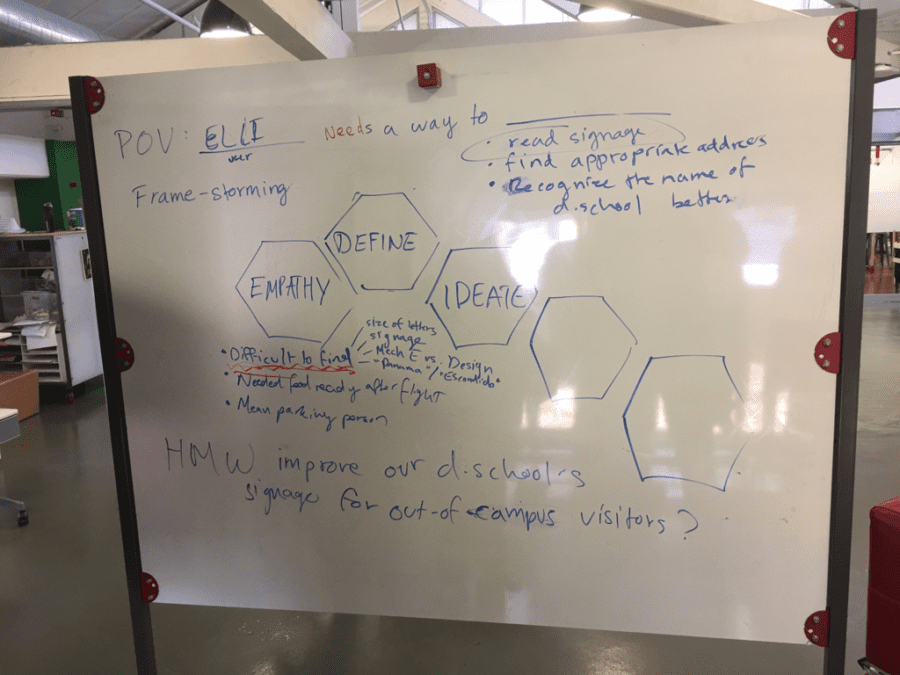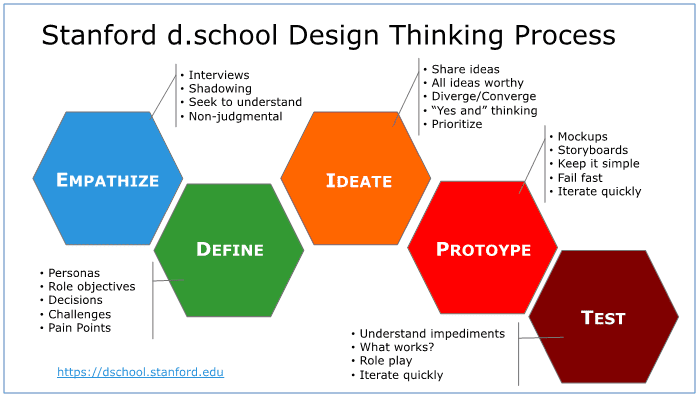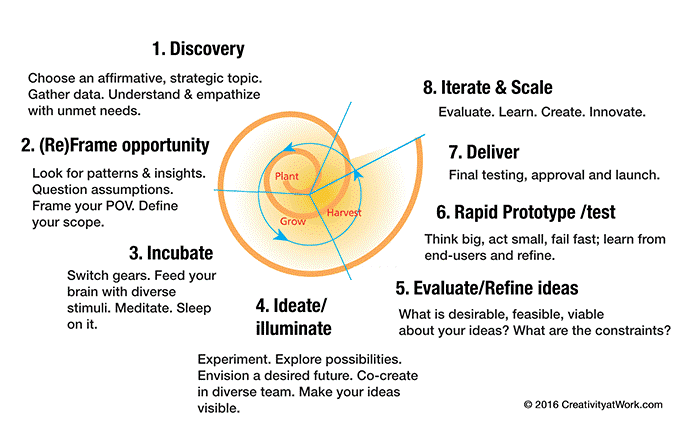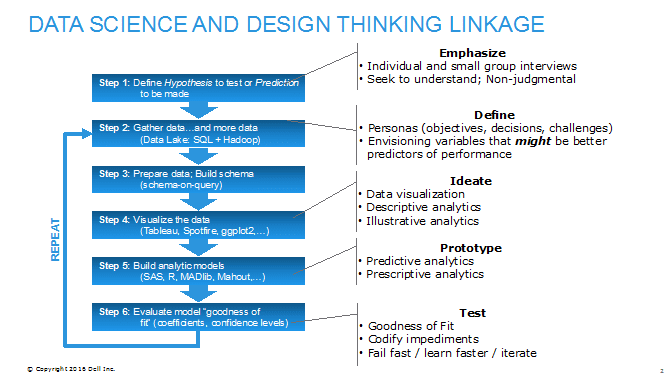I am so blessed with smart friends, and I am fortunate to count John Morley among that group. John recently introduced me to Stanford’s Design School (d.school). To say I was blown away would be an understatement. I was so jazzed by the one-hour tour that I have signed up for a 3-hour class (very expensive…costs like $12…my Starbucks coffee that will get me fired up for the class costs almost that much).
So what about design thinking got me so jazzed? Three things immediately jumped out at me about the design thinking concept:
- The design techniques that the school teaches are very similar to the envisioning techniques that we use in our Vision Workshop consulting engagements at Dell EMC, so I’ve uncovered this opportunity to expand our Vision Workshop methodology with some new tools, tips, and techniques.
- There appears to be a very close correlation between the design thinking approach and our data science engagement approach.
- These design techniques might be the key to unleashing an organization’s innovation potential today, instead of waiting impatiently for the next generation of business leaders to embrace analytics as a business discipline
What is Design Thinking?
Human-centered design is all about building a deep empathy with the people you’re designing for; generating tons of ideas; building a bunch of prototypes; sharing what you’ve made with the people you’re designing for; and eventually putting your innovative new solution out in the world.
There is a good reason why Stanford’s d.school does not sit within one of their existing schools because design thinking is used in almost all of Stanford’s schools including business, computer science, electrical, mechanical and even health care. Design thinking appears to be one of the secret sauces to Stanford’s success and cultivating the entrepreneurial spirit of its students and faculty (and neighbors, in my case). See Figure 1.
Figure 1: Stanford Design Thinking Process
The Design Thinking process involves the following 5 steps, with lots of iterations between these steps:
In our tour, the problem we addressed was making it easier to find the design school on the Stanford campus (Google Map didn’t help). So after some quick brainstorming, we came up with an idea of creating a design school specific Pokémon so that we could use Pokémon Go to lead us to the design center (that was actually my idea!!!). Then we tested the idea with a block of wood (representing Pokémon Go on a smartphone) and another participant wore a Post-It note with a Pokémon sketched character on it (they were the “Pokémon” virtual guide). It was fun. It was cool. And it was a real idea. And we generated, vetted and tested the idea in less than 15 minutes.
The below graphic from Creativity At Work provides another very useful perspective on the design thinking process (see Figure 2).
Figure 2: Creativity At Work Design Thinking Process
Companies including IDEO, Google, Apple, Uber, Netflix and SalesForce.com have embraced design thinking at the core of their business models. Almost everyone coming out of Stanford’s business, computer science and engineering schools have been taught the design thinking concepts. The influence of design thinking is growing among “digital first” organizations.
Intuit is another organization that has embraced Design Thinking to create a more engaging, more prescriptive user experience. From the article “Use ‘Design Thinking’ To Reach Customers,” we get the following:
Design thinking’s ability to uncover customers’ unarticulated needs and its processes for testing potential success with small inexpensive experiments provided the framework they needed. The team ultimately focused on three core design principles: “customer empathy,” “go broad before narrow” and “rapid experimentation.”
I love the phrase: “Uncover customers’ unarticulated needs.” The heart to any organization looking to become more innovative and creative in their thinking is to “uncover customers’ unarticulated needs.” It is likely the biggest operationalization challenge when it comes to integrating data science into an organization’s business models; to help organizations to become more effective at leveraging data and analytics to uncover their customers’ unarticulated needs.
Relationship between Design Thinking and Data Science
Our data science team at Dell EMC has embraced a Data Science Engagement process geared to the rapid brainstorming and testing of variables and metrics that might be better predictors of business performance; very much a “fail fast / learn faster” mentality. Maybe it shouldn’t be a surprise that our data science Vision Workshop engagements leverage many of the same concepts promoted by design thinking (see Figure 3).
Figure 3: Dell EMC Data Science Engagement Process
To support this “fail fast / learn faster” environment, we do our preliminary data science work using small data sets (10 to 20 GB) on jazzed up laptops (running all of our favorite data management and data science tools). We do this to accelerate the “fail fast / learn faster” process. We don’t want to get hung up on spending lots of time and resources setting up a big analytic sandbox with large data sets. Just the aggregation, cleansing, aligning, transforming and enriching of large terabyte-sized data sets can substantially hinder the rapid “fail fast / learn faster” data science process. We can learn a lot about the variables and metrics that might be better predictors of business performance in a small environment before we start to operationalize the resulting data and analytics in our data lake.
However if you already have a data lake that supports data-as-a-service and analytics-as-a-service, then you are good to go. Unfortunately many organizations don’t have such an environment, or worse yet, they have multiple data lakes that dramatically increase the probability that multiple versions of the same data are in play (at topic for a later blog).
Design Thinking Summary
Design Thinking and the Data Science Engagement process naturally complement each other – seeking to leverage creative and open thinking to engage the entire organization to identify those variables and metrics that might be better predictors of performance. Maybe, just maybe, design thinking is the key to unleashing the creative and innovative resources of the entire organization. Our Vision Workshop engagements certainly validate that this type of innovative thinking works and can unleash the creative capabilities of the organization. Guess I really didn’t need to look any further than across the street at Stanford’s d.school to finally make that connection.




